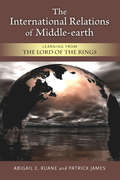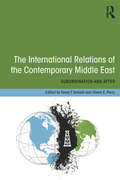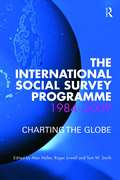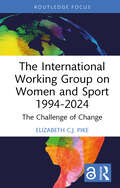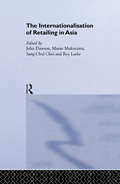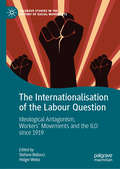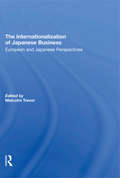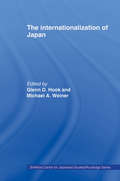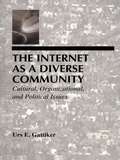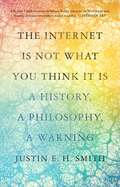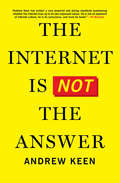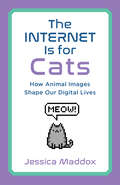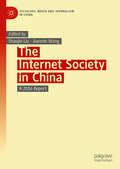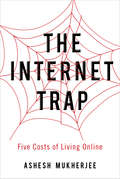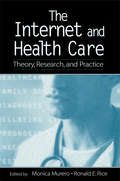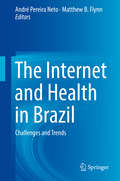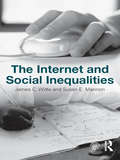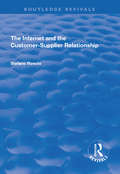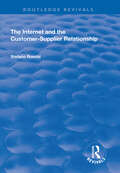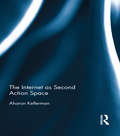- Table View
- List View
The International Relations of Middle-earth: Learning from the Lord of the Rings
by Abigail E. Ruane Patrick JamesBased on their successful undergraduate course at the University of Southern California, Abigail E. Ruane and Patrick James provide an introduction to International Relations using J. R. R. Tolkien's fantastically popular trilogy The Lord of the Rings. Because Tolkien's major themes---such as good versus evil and human agency versus determinism---are perennially relevant to International Relations, The Lord of the Rings is well suited for application to the study of politics in our own world. This innovative combination of social science and humanities approaches to illustrate key concepts engages students and stimulates critical thinking in new and exciting ways.
The International Relations of the Contemporary Middle East: Subordination and Beyond (Contemporary Issues In The Middle East Ser.)
by Tareq Y. Ismael Glenn E. PerryThe Middle East, a few decades ago, was seen to be an autonomous subsystem of the global international political system. More recently, the region has been subordinated to the hegemony of a singular superpower, the US, bolstered by an alliance with Israel and a network of Arab client states. The subordination of the contemporary Middle East has resulted in large part from the disappearance of countervailing forces, for example, global bipolarity, that for a while allowed the Arab world in particular to exercise a modicum of flexibility in shaping its international relations.The aspirations of the indigenous population of the Middle East have been stifled by the dynamics of the unequal global power relationships, and domestic politics of the countries of the region are regularly subordinated to the prerogatives of international markets and the strategic competition of the great powers. Employing the concept of imperialism, defined as a pattern of alliances between a center (rulers) in the Center (developed) country and a center (client regime) in the Periphery (underdeveloped country) - as an overall framework to analyse the subordination of the region, this book is essential reading for students and scholars of the Middle East, International Relations, and Politics in general.
The International Social Survey Programme 1984-2009: Charting the Globe (Social Research Today)
by Roger Jowell Max Haller Tom W. SmithThe social sciences rely more on the comparative method than on experimental data mainly because the latter is difficult to acquire amongst human populations. The International Social Survey Programme has played a pioneering role in creating and sustaining methodologically-sophisticated mass attitude surveys across the globe. Starting in 1984 with five nations, it now encompasses forty-five nations spread over five continents, each administering an identical annual survey to a random sample of their population. Analyses of the data or descriptions of the methodology already appear in over 3,000 publications. This book contains new contributions from three dozen eminent scholars who analyse and compare the perceptions and attitudes of citizens across all five continents, nations and over time. Subjects range from inequality and the role of the state; ethnic, national and global identities; the changing relevance of religion, beliefs and practices; gender roles, family values and work orientations; household and society. Some chapters focus on methodological issues; others focus on substantive findings. This book sets new standards for cross-cultural research.
The International Trafficking of Human Organs: A Multidisciplinary Perspective (Advances in Police Theory and Practice)
by Leonard Territo Rande MattesonInternational illicit trade in human organs is on the increase, fueled by growing demand and unscrupulous traffickers. In order to truly understand the problem of organ trafficking, an analysis should take into account the various perspectives that come into play in this multifaceted issue. With contributions from international scholars and experts
The International Workers’ Relief, Communism, and Transnational Solidarity: Willi Münzenberg in Weimar Germany (Palgrave Studies in the History of Social Movements)
by Kasper BraskénThe first major study on the making of new cultures, movements and public celebrations of transnational solidarity in Weimar Germany. The book shows how solidarity was used to empower the oppressed in their liberation and resistance movements and how solidarity networks transferred visions and ideas of an alternative global community.
The International Working Group on Women and Sport 1994-2024: The Challenge of Change (ISSN)
by Elizabeth C.J. PikeThis book comprehensively evaluates the role of the International Working Group on Women and Sport (IWG) – the world’s largest network dedicated to advancing gender equity and equality in sport, physical education, and physical activity – in influencing global and domestic policy and practice.The issues addressed by the IWG in its first three decades of activism reflect global socio-political progress, as well as emergent new problems, for women, sport, and human rights. The IWG’s commitment to collaboration with, among others, the International Olympic Committee and the United Nations has provided the foundations for globally accepted frameworks to address gender-based issues in and through sport. The advocacy work of the IWG is told via first-hand interviews with key personnel from each of the IWG Secretariats, from its establishment in 1994 to 2024, providing insight into the most significant issues, achievements, and outcomes for the international social movement for women and sport.The book is a useful resource for students in the sociology of sport, sport policy, leadership, management, coaching, and gender studies. It is also relevant to sport administrators, practitioners, policymakers, and those working in gender governance.
The Internationalisation of Retailing in Asia (Routledge Advances in Asia-Pacific Business)
by John Dawson Roy Larke Masao Mukoyama Sang Chul ChoiEuropean retailers have successfully internationalised their activities in Europe but have been less successful in North America. American retailers have been successful in their home market but less so in Europe. The major European and American retailers are now entering Asia and competing directly with each other in a substantive way fort he first time. These Western retailers, using modern managerial methods, are entering markets typified by more traditional managerial approaches. Western managerial cultures and values are interfacing with Asian ones. The results of these moves are new stresses for Asian retail structures that bring a new dynamism to Asian retailing. The contributions in this book explore the conflicts and benefits that arise as retailing in Asia becomes internationalised. The contributions are provided by experts in retail research from across Asia and for the first time in depth analyses are provided of the ways that Western retailers are provoking change in Asia. The book results form a seminar held at the University of Marketing and Distribution Sciences, Kobe, in November 2001 under the auspices of Society for Asian Research in Distribution. Scholars from across the region presented research results of their analyses of the New Commerce now appearing in Asia.
The Internationalisation of the Labour Question: Ideological Antagonism, Workers’ Movements and the ILO since 1919 (Palgrave Studies in the History of Social Movements)
by Stefano Bellucci Holger WeissThis edited collection is a global history of workers’ organisations since 1919, the year when the International Labour Organisation (ILO), the Comintern and the International Federation of Trade Unions were formed. This historical moment represents a caesura in labour history as it epitomises the beginning of what the editors and the contributors in this book call the internationalisation of the labour question. The case studies in this centenary volume analyse the relationship between global workers’ organisations and the new ideological confrontation between liberal capitalism, socialism and communism since the Bolshevik Revolution in Russia. Workers’ organisations, trade unions in particular, grew in importance and managed to organise internationally, forming alliances cemented by ideology and sustained by international institutional bodies or centrals. In the nascent capitalist versus communist struggle, trade unions thrived. Is it mere coincidence that today’s decline of unionism coincides with the end of ideological antagonism? This book emphasises important global labour issues such as gender as well as international workers’ histories from Latin America, Asia and Africa.
The Internationalization Of Japanese Business: European And Japanese Perspectives
by Malcolm TrevorThis book examines the progress of internationalisation of European and Japanese business in four different fields: the commodities and service trade, capital transfers, enterprise management, and information and culture.
The Internationalization of Japan (The University of Sheffield/Routledge Japanese Studies Series)
by Glenn D. Hook Michael A. WeinerThe Internationalization of Japan provides the English-speaking reader with the opportunity to hear what some of Japan's leading social scientists and other commentators have to say about the internationalization of their country as well as their country's impact overseas.The topic is of extreme importance now as the international community demands a greater Japanese contribution to international society as well as changes in Japan to facilitate foreign access. The book discusses the internationalization of politics, economy and society. Topics of special interest include the internationalization of Japanese capital, the response of Japanese society to foreign workers, local level initiatives for internationalization and the internationalization of education.To place the internationalization of Japan in comparative perspective there are chapters on Britain and the United States from a leading British and a leading American political scientist respectively. These two and the editors aside, all the contributors are highly regarded Japanese scholars or commentators.
The Internet As A Diverse Community: Cultural, Organizational, and Political Issues (LEA Telecommunications Series)
by Urs E. GattikerIn this volume, author Urs Gattiker offers a broad overview of Internet and technology-related theory. He examines Internet and multimedia issues from an international perspective, outlining issues of international sovereignty and the potential impact of national interests on global technology policy. He also surveys the issues of regulation and institutionalization of the Internet, examines ways for reducing the inequality of benefits from such technology, and explores the opportunities and challenges the Internet offers for consumers, firms, governments, and interest groups. In assembling this treatise, Gattiker synthesizes a vast body of literature from communication, economics, philosophy, political science, management, psychology, science policy, telecommunication engineering, and other areas. The Internet as a Diverse Community provides readers with a framework for analyzing and selecting between many different Internet choices. It explores issues from a social-impact perspective, using examples from a variety of contexts and firms around the world. The work also offers a wealth of new social theory on such topics as moral and ethical issues and the opportunities, choices, and challenges the Internet offers for consumers, investors, managers, and public policy decision makers. It examines the current and future challenges that computer-mediated technologies present, and sets forth new theoretical perspectives on such areas as multimedia and the profit-maximizing firm; the Internet and the private user; managing multimedia productively; and the social and moral costs of various Internet options and choices. Taken as a whole, this resource provides valuable insights on the Internet and is essential reading for business, telecommunication, public policy, and technology decision makers around the globe.
The Internet Is Not What You Think It Is: A History, a Philosophy, a Warning
by Justin E. SmithAn original deep history of the internet that tells the story of the centuries-old utopian dreams behind it—and explains why they have died todayMany think of the internet as an unprecedented and overwhelmingly positive achievement of modern human technology. But is it? In The Internet Is Not What You Think It Is, Justin Smith offers an original deep history of the internet, from the ancient to the modern world—uncovering its surprising origins in nature and centuries-old dreams of radically improving human life by outsourcing thinking to machines and communicating across vast distances. Yet, despite the internet’s continuing potential, Smith argues, the utopian hopes behind it have finally died today, killed by the harsh realities of social media, the global information economy, and the attention-destroying nature of networked technology.Ranging over centuries of the history and philosophy of science and technology, Smith shows how the “internet” has been with us much longer than we usually think. He draws fascinating connections between internet user experience, artificial intelligence, the invention of the printing press, communication between trees, and the origins of computing in the machine-driven looms of the silk industry. At the same time, he reveals how the internet’s organic structure and development root it in the natural world in unexpected ways that challenge efforts to draw an easy line between technology and nature.Combining the sweep of intellectual history with the incisiveness of philosophy, The Internet Is Not What You Think It Is cuts through our daily digital lives to give a clear-sighted picture of what the internet is, where it came from, and where it might be taking us in the coming decades.
The Internet Is Not the Answer
by Andrew KeenSince its creation during the Cold War, the Internet, together with the Web, personal computers, tablets and smartphones, has ushered in one of the greatest shifts in society since the Industrial Revolution. The Digital Revolution has contributed to the world in many positive ways, but we are less aware of the Internet’s deeply negative effects.The Internet Is Not the Answer, by longtime Internet skeptic Andrew Keen, offers a comprehensive look at what the Internet is doing to our lives. The book traces the technological and economic history of the Internet, from its founding in the 1960s through the rise of big data companies to the increasing attempts to monetize almost every human activity. In this sharp, witty narrative, informed by the work of other writers, reporters, and academics, as well as his own research and interviews, Keen shows us the tech world, warts and all.Startling and important, The Internet Is Not the Answer is a big-picture look at what the Internet is doing to our society and an investigation of what we can do to try to make sure the decisions we are making about the reconfiguring of our world do not lead to unpleasant, unforeseen aftershocks.
The Internet Is for Cats: How Animal Images Shape Our Digital Lives
by Jessica MaddoxLOL cats. Grumpy Cat. Dog-rating Twitter. Pet Instagram accounts. It’s generally understood the internet is for pictures of cute cats (and dogs, and otters, and pandas). But what motivates people to make and share these images, and how do they relate to other online social practices? The Internet is for Cats examines how animal images are employed to create a lighter, more playful mood, uniting users within online spaces that can otherwise easily become fractious and toxic. Placing today’s pet videos, photos, and memes within a longer history of mediated animal images, communication scholar Jessica Maddox also considers the factors that make them unique. She explores the roles that animals play within online economies of cuteness and attention, as well as the ways that animal memes and videos respond to common experiences of life under neoliberalism. Conducting a rich digital ethnography, Maddox combines observations and textual analysis with extensive interviews of the people who create, post and share animal media, including TikTok influencers seeking to make their pets famous, activists tweeting about wildlife conservation, and Redditors upvoting every cute cat photo. The Internet is for Cats will leave you with a new appreciation for the human social practices behind the animal images you encounter online.
The Internet Society in China: A 2016 Report (Sociology, Media and Journalism in China)
by Jianmin Wang Shaojie LiuThis book provides a cutting edge analysis of the rapid rise of China’s network society and reviews recent key developments within China’s internet economy, notably the concepts of “Lucky Money” and E-Business on Wechat, and Crowd-Funding Platforms. It focuses on drawing out the sociological impact of these economic developments, examining among others the bearing of the decentralization of e-business in rural areas. It offers a vital sociological perspective on the development of China’s internet society and how it affects social and professional relations, examining the shift from the traditional Red Envelope Giving Culture to Digital Red Envelope, micro charity 2.0 as well as the Rise of Internet Crowd Funding in China. Combining an up to date analysis of the current state of play of China’s internet society with expertise in the rapidly changing landscape of China’s social media, this book provides key insights into how technology impacts on the communication and movement of population in China, in both social and economic spheres.
The Internet Trap: Five Costs of Living Online
by Ashesh MukherjeeWhether we are checking emails, following friends on Facebook and Twitter, catching up on gossip from TMZ, planning holidays on TripAdvisor, arranging dates on Match.com, watching videos on Youtube, or simply browsing for deals on Amazon, the internet pervades our professional and personal environments. The internet has revolutionized our lives, but at what cost?In The Internet Trap, Ashesh Mukherjee uses the latest research in consumer psychology to highlight five hidden costs of living online: too many temptations, too much information, too much customization, too many comparisons, and too little privacy. The book uses everyday examples to explain these costs including how surfing the internet anonymously can encourage bad behavior, using social media can make us envious and unhappy, and doing online research can devalue the product finally chosen. The book also provides actionable solutions to minimize these costs. For example, the book reveals how deciding not to choose is as important as deciding what to choose, setting up structural barriers to temptation can reduce overspending on e-commerce websites, and comparisons with others on social media websites needs to be cold rather than hot. The Internet Trap provides a new perspective on the dark side of the internet, and gives readers the tools to become smarter users of the internet.
The Internet and Formations of Iranian American-ness: Next Generation Diaspora
by Donya AlinejadThis book explores how the children of Iranian immigrants in the US utilize the internet and develop digital identities. Taking Los Angeles—the long-time media and cultural center of Iranian diaspora—as its ethnographic field site, it investigates how various web platforms are embedded within the everyday social, cultural, and political lives of second generation Iranian Americans. Donya Alinejad unpacks contemporary diasporic belonging through her discussion of the digital mediation of race, memory, and long-distance engagement in the historic Iranian Green Movement. The book argues that web media practices have become integral to Iranian American identity formation for this generation, and introduces the notion of second-generation “digital styles” to explain how specific web applications afford new stylings of diaspora culture.
The Internet and Health Care: Theory, Research, and Practice (Routledge Communication Series)
by Ronald E. Rice Monica MureroThe Internet and Health Care: Theory, Research, and Practice presents an in-depth introduction to the field of health care and the Internet, from international and interdisciplinary perspectives. It combines expertise in the areas of the social sciences, medicine, policy, and systems analysis. With an international collection of contributors, it provides a current examination of key issues and research projects in the area. Methods and data used in the chapters include personal interviews, focus groups, observations, regional and national surveys, online transcript analysis, and much more. Sections in the book cover:*e-Health trends and theory; *searching, discussing, and evaluating online health information at the individual level of analysis; *discussing health information at the group or community level; and *implementing health information systems at the regional and social level. The Internet and Health Care will prove useful for university educators and students in the social, public health, and medical disciplines, including Internet researchers. It is also oriented to professionals in many disciplines who will appreciate an integrative theoretical, empirical, and critical analysis of the subject matter, including developers and providers of online health information.
The Internet and Health in Brazil: Challenges and Trends
by André Pereira Neto Matthew B. FlynnThe popularization of the Internet, due in larger part to the advent of multifunctional cell phones, poses new challenges for health professionals, patients, and caregivers as well as creates new possibilities for all of us. This comprehensive volume analyzes how this social phenomenon is transforming long-established healthcare practices and perceptions in a country with one of the highest numbers of Internet users: Brazil. After an opening text that analyzes the Internet and E-Health Care as a field of study, the book comprises six parts. The first part introduces the emergence and development of the internet in Brazil, its pioneering experience in internet governance, digital inclusion, and online citizen participation. The second part is dedicated to internet health audiences by analyzing the cases of patients, the young, and the elderly seeking and sharing health information online, especially in virtual communities. The third part is dedicated to the challenges that the expansion of the internet in healthcare poses to all of us, such as the evaluation of the quality of health information available online and the prevention of the risks involved with online sales, cyberbullying, and consumption of prescription medicines. The fourth presents some innovative e-learning experiences carried out with different groups in Brazil, while the fifth part analyses some practical applications involving the Internet and health, including studies on M-Health, the Internet of things, serious games and the use of new information and communication technologies in health promotion. The last chapter analyses the future of healthcare in the Internet Age. The authors establish a critical and creative debate with international scholarship on the subject. This book is written in a direct and comprehensible way for professionals, researchers, students of communication and health, as well as for stakeholders and others interested in better understanding the trends and the different challenges related to the social phenomenon of the internet in health.
The Internet and New Social Formation in China: Fandom Publics in the Making (Media, Culture and Social Change in Asia)
by Weiyu ZhangThere are billions of internet users in China, and this number is continually growing. This book looks at the various purposes of this internet use, and provides a study about how the entertainment-consuming users form into publics through the mediation of technologies in the era of network society. It questions how individuals, mediated by new information and communication technologies, come together to form new social categories. The book goes on to investigate how public(s) is formed in the era of network society, with particular focus on how fans become publics in a society that follows the logic of network. Using online surveys and in-depth interviews, this book provides a rich description of the process of constructing a new social formation in contemporary China.
The Internet and Politics: Citizens, Voters and Activists (Democratization Studies)
by Diana Owen Sarah Oates Rachel K GibsonThis volume explores the nature of the Internet's impact on civil society, addressing the following central questions: is the Internet qualitatively different from the more traditional forms of the media? has the Internet demonstrated real potential to improve civil society through a wider provision of information, an enhancement of communication between government and citizen, or via better state transparency? does the Internet pose a threat to the coherence of civil society as people are encouraged to abandon shared media experiences and pursue narrow interests? in authoritarian states, does the Internet function as a beacon for free speech or as another tool for propaganda?
The Internet and Social Inequalities
by James C. Witte Susan E. MannonIdeal for use as a core or secondary text in lower division social inequalities or social problems courses, this book explains how the changing nature and uses of the Internet not only mirror today’s social inequalities, but also are at the heart of how stratification is now taking place.? A pioneering work, both intellectually, and pedagogically.
The Internet and the Customer-Supplier Relationship
by Stefano RonchiThis title was first published in 2003. An exhaustive and synthetic framework for the use of Internet tools in customer-supplier relationships is one aspect of e-business that is still missing from existing literature. This book analyses the main management implications related to the adoption of the Internet in the supply chain and unifies different research studies and contributions in order to build such a framework. It is based on wide empirical evidence including four in-depth case studies in both Europe and the US, a cross-industry survey of more than 160 US companies and website research describing emerging Internet initiatives in B2B relationships. By creating a concrete link between theory and practice it should appeal to academics and practitioners alike.
The Internet and the Customer-Supplier Relationship (Routledge Revivals)
by Stefano RonchiThis title was first published in 2003. An exhaustive and synthetic framework for the use of Internet tools in customer-supplier relationships is one aspect of e-business that is still missing from existing literature. This book analyses the main management implications related to the adoption of the Internet in the supply chain and unifies different research studies and contributions in order to build such a framework. It is based on wide empirical evidence including four in-depth case studies in both Europe and the US, a cross-industry survey of more than 160 US companies and website research describing emerging Internet initiatives in B2B relationships. By creating a concrete link between theory and practice it should appeal to academics and practitioners alike.
The Internet as Second Action Space
by Aharon KellermanOne of the most significant and important advancements in information and communication technology over the past 20 years is the introduction and expansion of the Internet. Now almost universally available, the Internet brings us email, global voice and video communications, research repositories, reference libraries, and almost unlimited opportunities for daily activities. Bridging geographical distances in unprecedented ways, the Internet has impacted all aspects of our daily lives – from facilitating the running of businesses, the attainment of services and keeping in touch with friends and family. Accessible at any time and for many of us from our mobile phones, the Internet has opened up a world of knowledge and communication platforms that we cannot now imagine living without. This book explores the concept that the Internet has become a second action space for individuals. Coexisting with traditional and "obvious" real space, the Internet serves as a novel spatial platform and action space to its subscribers all over the world. Kellerman expertly discusses this notion and examines the practical integration of cyberspace with real space. Part I examines the Internet as a platform for action and presents its relations with physical space concerning a range of uses and applications which were traditionally performed in physical space only. It discusses the idea that the Internet has become a second space and explores theoretical perspectives surrounding this notion. The Internet has undeniably made humankind more efficient and connected. Part II explores the Internet as an action space for human life, considering basic human needs, curiosity, identity and social relations. It further considers instances whereby use and application of the Internet cannot be fully performed in real space, mainly regarding people’s presentation of identity. Part III explores daily actions over the Internet, such as work, shopping, banking and social interactions. Kellerman also briefly touches on the darker aspects that the expansion of the Internet has made possible – including its role in fraud and other crimes. The concluding chapter discusses people living across the two spaces and identifies potential future developments. The Internet as Second Actions Space will appeal to students across the social sciences, in particular those studying Geography, Sociology, Media Studies, Internet Studies, Business and related disciplines.
